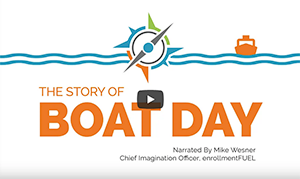Author Jeannette Walls wrote: “Sometimes you need a little crisis to get your adrenaline flowing and help you realize your potential.” As enrollment managers everywhere scramble to digitalize their entire operations, there is a great opportunity to experiment with new recruiting techniques. If you surprise your audience by virtually connecting with them in creative ways, you will stand out to them.
- Send potential students a video message.
Embedding a video within an email creates higher levels of engagement than text alone. Many CRMs allow users to insert short videos into emails. If your system doesn’t have this functionality, there are software programs such as BombBomb that make it easy for users to quickly record a video with their webcam and embed it into a Gmail or Outlook email. Individualized videos sent by admissions counselors add interest and impact. Most email solutions also allow you to determine who clicked your video to watch, providing data to identify your most engaged prospects.
- Allow prospective students to audit virtual classes.
Sitting in on a class is a tried-and-true component of the accepted student experience. Don’t let the physical closure of your campus deprive accepted students of learning about this critical aspect of their academic experience--the instruction they can expect to receive in the classroom. While many colleges were forced to pull together virtual spring and summer classes on the fly, and are reluctant to open them to prospective students, you can distinguish yourself by pulling back the curtain and showcasing your most engaging faculty members. By doing this, you offer convincing evidence of how instructors connect with their students, irrespective of the instructional modality. Ohio Wesleyan University’s We’re In This Together course provides a good example of making a free class available to the public, including prospective students.
- Narrate a real-time campus tour using existing multimedia.
Even the slickest virtual video tour is no match for a tour led by a real live member of your school. Why? Campus tours led by humans allow for interaction, Q&A, and the fostering of a real connection to your community. Since prospective students are now unable to visit campus, and your staff and student ambassadors are working from home, this is the time to dig in and make use of the multimedia repository you’ve compiled over the years but never fully utilized. Ask your visit coordinator or an admission counselor to compile your best photos and videos into a slideshow that mirrors your campus tour. Advertise that campus tours are hosted live by your superstar student ambassadors or the admissions staff. This format opens the door for the types of dialogue that occurs in an on-campus college tour. You can do this using a PowerPoint deck, or use tools such as Animoto or Vimeo, which allow you to create professional-looking videos without a videographer’s skills.
- Connect emotionally by acknowledging the anxiety students are feeling.
Author and storyteller Jonah Sachs reminds us that “Good marketers see consumers as complete human beings with all the dimensions real people have.” As you craft messages to prospective students during times of crisis, acknowledge the anxiety that both the institution and the audience are feeling together. There is real potential for a human connection here. If you do the opposite – which is to pretend everything is normal – you’ll lose all authenticity. Seek a bond based on shared emotion.
To recap, the element of surprise is your best friend. Connect with your audience during the COVID-19 pandemic by 1) sending prospective families video messages, 2) allowing students to audit virtual classes, 3) narrating virtual tours with existing multimedia, and 4) understanding and recognizing the anxiety everyone is feeling—keep it real. If you want to quantify and measure the success of your tactics, compare the engagement with control groups. Ask yourself questions like “Are accepted students clicking through emails with an embedded video at a higher rate than emails without a video?” and “Are accepted students sitting in on virtual classes at higher rates than they sat in on in-person classes?”. At the end of the cycle, compare the conversions of each of these sub-groups to past cohorts.
The best part is that, in addition to differentiating yourself now, you are likely to find creative recruiting techniques with benefits that go well beyond our current challenging times.




